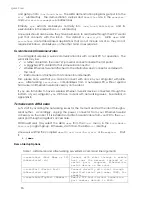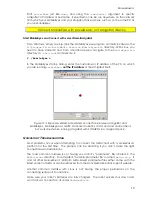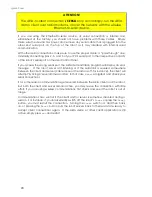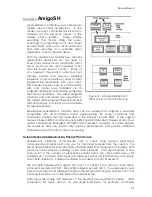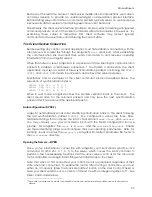
What isAmigoBot?
Software-wise, the Pioneer 1 initially served as a platform for SRI International's AI/fuzzy
logic-based Saphira robotics applications development. But it wasn't long before
Pioneer’s open architecture became the popular platform for the development of a
variety of alternative robotics software environments.
Pioneer AT
Functionally and programmatically identical to the Pioneer 1, the four-wheel drive, skid-
steer Pioneer AT was introduced in the summer of 1997 for operation in uneven indoor
and outdoor environments, including loose, rough terrain.
Figure 7. The Performance
PeopleBot sports an attractive
body design and bundled
systems, including voice
synthesis and recognition for
human-interaction research
and applications.
Except for the drive system, there were no operational differences between the Pioneer
AT and the Pioneer 1: The integrated sonar arrays
and controllers were the same; they shared
accessories; and applications developed for the
Pioneer 1 worked with little or no porting on the AT.
Pioneer 2™ and PeopleBot™
The next generation of Pioneer, including the
Pioneer 2-DX, -CE, and -AT, introduced in fall of 1998
through summer of 1999, improved upon the Pioneer
1 legacy while retaining its many important
advantages.
Indeed, in most respects, particularly
with applications software, Pioneer 2 worked
identically to Pioneer 1 models, but offered many
more expansion options, including a client PC
onboard the robot.
The
Activ
Media Robotics Pioneer 2 models -DX, -DE, -
DXe, -DXf, and -AT, and the V1 and Performance
PeopleBot robots used a 20 MHz Siemens 88C166-
based controller, with independent motor-power
and sonar controller boards for a versatile operating
environment. Sporting a more holonomic body,
larger wheels and stronger motors for better indoor
performance, Pioneer 2-DX, -DXe, -DXf, and -CE
models, like Pioneer 1, were two-wheel, differential-
drive mobile robots.
The four-wheel drive Pioneer 2-AT had four
independent motors and drivers. Unlike its Pioneer
AT predecessor, the Pioneer 2-AT came with a stall-detection system and inflatable
pneumatic tires with metal wheels for much more robust operation in rough terrain, as
well as the ability to carry nearly 30 kilograms (66 lbs) of payload and climb a 60-percent
grade.
Other Pioneer 2-like robots include the Performance PeopleBot robots, which were
introduced in 2000. They are architecturally Pioneer 2 robots, but with stronger motors
and integrated human-interaction features, including a pedestal extension, integrated
voice and sound synthesis and recognition—ideal for human-interaction studies as well
as for commercial and consumer mobile-robotics applications.
8
2
Price/performance ratio included! The much more capable and expandable Pioneer 2 was introduced four
years later for just a few hundred dollars (US) more than the original Pioneer 1.






















